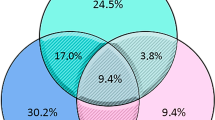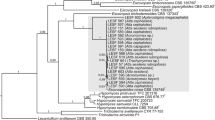Abstract
Fungus-growing ants of the genus Atta are known for their leaf-cutting habit, a lifestyle they have maintained since their 50-million-year-old co-evolution with a mutualistic fungus, cultivated as food. Recent studies have highlighted that, in addition to the mutualistic fungus, nests of ants harbor a great diversity of microbial communities. Such microorganisms include the dematiaceous fungi, which are characterized by their melanized cell walls. In order to contribute to the knowledge of fungal ecology, as well as opportunistic strains that may be dispersed by these social insects, we isolated and identified fungi carried by gynes of Atta capiguara and Atta laevigata, collected from colonies located in Fazenda Santana, Botucatu (São Paulo, Brazil). The isolation was carried out using the oil flotation technique, which is suitable for the growth of black fungi. Inoculated plates were incubated at 25 and 35 °C until black cultures were visible (20–45 days). Isolates were identified based on microscopic and molecular characteristics. Some isolated genera were: Cladophialophora, Cladosporium, Exophiala, Ochroconis, Phaeococcomyces, Phialophora and Penidiella. Hyaline species were also found. The results obtained from this work showed that leaf-cutting gynes may contribute to the dispersal of opportunistic dematiaceous fungi. It is suggested that more attention should be paid to this still unexplored subject.

Similar content being viewed by others
References
Altschul SF, Madden TL, Schäffer AA, Zhang J, Zhang Z, Miller W, Lipman DJ (1997) Gapped BLAST and PSI-BLAST: a new generation of protein database search programs. Nucleic Acids Res 25:3389–3402. doi:10.1093/nar/25.17.3389
Attili-Angelis D, Duarte APM, Pagnocca FC, Nagamoto NS, de Vries M, Stielow JB, de Hoog GS (2014) Novel Phialophora species from leaf-cutting ants (tribe Attini). Fungal Divers 65:65–75. doi:10.1007/s13225-013-0275-0
Autuori M (1941) Contribuição para o conhecimento da saúva (Atta spp.). I. Evolução do sauveiro (Atta sexdens rubropilosa Forel, 1908). Arq Inst Biol São Paulo 12:197–228
Bass M, Cherrett JM (1995) Fungal hyphae as a source of nutrients for the leaf-cutting ant Atta sexdens. Physiol Entomol 20:1–6. doi:10.1111/j.1365-3032.1995.tb00793.x
Benson DA, Karsch-Mizrachi I, Clark K, Lipman DJ, Ostell J, Sayers EW (2012) GenBank. Nucleic Acids Res 40:D48–D53. doi:10.1093/nar/gkr1202
Bueno OC, Campos-Farina AEC (1999) Formigas Urbanas: estratégias de controle. Vetores & Pragas, Brazil
Capriler CH, Mata S, Middelveen M (1989) Preservation of fungi in water (Castellani): 20 years. Mycopathologia 106:73–79. doi:10.1007/BF00437084
Colwell RK (2006) Estimate S: statistical estimation of species richness and shared species from samples. http://purl.oclc.org/estimates. Accessed 01 April 2014
Crous PW, Samson RA (2010) CBS Laboratory manual series: food and indoor fungi. CBS-KNAW Fungal Biodiversity Centre, Utrecht
Crous PW, Verkley GJM, Groenewald JZ, Samson RA (2009a) Fungal biodiversity. CBS Laboratory manual series. CBS-KNAW Fungal Biodiversity Centre, Utrecht
Crous PW, Summerell BA, Carnegie AJ, Wingfield MJ, Groenewald JZ (2009b) Novel species of Mycosphaerellaceae and Teratosphaeriaceae. Persoonia 23:119–146. doi:10.3767/003158509X479531
de Hoog GS, Haase G (1993) Nutritional physiology and selective isolation of Exophiala dermatitidis. Antonie Leeuwenhoek 64:17–26. doi:10.1007/BF00870917
de Hoog GS, Guarro J, Gené J, Figueras MJ (2000a) Atlas of clinical fungi. Centraalbureau voor Schimmelcultures/ Universitat Rovira i Virgili, Utrecht/Reus
de Hoog GS, Queiroz-Telles F, Haase G, Fernandez-Zeppenfeldt G, Angelis DA, van den Ende A, Matos T, Peltroche-Llacsahuanga H, Pizzirani-Kleiner AA, Rainer J, Richard-Yegres N, Vicente V, Yegres F (2000b) Black fungi: clinical and pathogenic approaches. Med Mycol 38:243–250. doi:10.1080/mmy.38.s1.243.250
de Hoog GS, Matos T, Sudhadham M, Luijsterburg KF, Haase G (2005) Intestinal prevalence of the neurotropic black yeast Exophiala (Wangiella) dermatitidis in healthy and impaired individuals. Mycoses 48:142–145. doi:10.1111/j.1439-0507.2004.01083.x
de Hoog GS, Zeng JS, Harrak MJ, Sutton DA (2006) Exophiala xenobiotica sp. nov., an opportunistic black yeast inhabiting environments rich in hydrocarbons. Antonie Leeuwenhoek 90:257–268. doi:10.1007/s10482-006-9080-z
Defossez E, Selosse M-A, Dubois MP, Mondolot L, Faccio A, Djieto-Lordon C, McKey D, Blatrix R (2009) Ant-plants and fungi: a new threeway symbiosis. New Phytol 182:942–949. doi:10.1111/j.1469-8137.2009.02793.x
Forti LC, Boaretto MAC (1997) Formigas cortadeiras: Biologia, ecologia, danos e controle. Universidade Estadual Paulista, Brazil
Gerrits van den Ende AHG, de Hoog GS (1999) Variability and molecular diagnostics of the neurotropic species Cladophialophora bantiana. Stud Mycol 43:151–162
Gibs AG (1998) Water-proofing properties of cuticular lipids. Am Zool 38:471–482. doi:10.1093/icb/38.3.471
Guedes FLA, Attili-Angelis D, Pagnocca FC (2012) Selective isolation of dematiaceous fungi from the workers of Atta laevigata (Formicidae: Attini). Folia Microbiol 57:21–26. doi:10.1007/s12223-011-0081-6
Gunde-Cimerman N, Sonjak S, Zalar P, Frisvad JC, Diderichsen B, Plemenitaš A (2003) Extremophilic fungi in arctic ice: a relationship between adaptation to low temperature and water activity. Phys Chem Earth 28:1273–1278. doi:10.1016/j.pce.2003.08.056
Hall TA (1999) BioEdit: a user-friendly biological sequence alignment editor and analysis program for Windows 95/98/NT. Nucleic Acids Symp Ser 41:95–98
Hoffmann CC, Danucalov IP, Purim KSM, Queiroz-Telles F (2011) Infecções causadas por fungos demácios e suas correlações anátomo-clinicas. An Bras Dermatol 86:138–141
Hölldobler B, Wilson EO (2008) Super organism. The beauty, elegance and strangeness of insect societies. Norton & Company, New York
Iwatsu T, Miyaji M, Okamoto S (1981) Isolation of Phialophora verrucosa and Fonsecaea pedrosoi from nature in Japan. Mycopathologia 75:149–158. doi:10.1007/BF00482809
Justi J Jr, Imenes SL, Bergmann EC, Campos-Farina AEC, Zorzenon FJ (1996) Formigas cortadeiras. Boletim Técnico do Instituto Biológico 4:5–31
Langfelder K, Streibel M, Jahn B, Haase G, Brakhage AA (2003) Biosynthesis of fungal melanins and their importance for human pathogenic fungi. Fungal Genet Biol 38:143–158
Little AE, Currie CR (2007) Symbiotic complexity: discovery of a fifth symbiont in the attine-microbe symbiosis. Biol Lett 3:501–504. doi:10.1098/rsbl.2007.0253
Marques SG, Silva CM, Saldanha PC, Rezende MA, Vicente VA, Queiroz-Telles F, Costa JM (2006) Isolation of Fonsecaea pedrosoi from the shell of the babassu coconut (Orbignya phalerata Martius) in the Amazon region of Maranhão Brazil. Jpn J Med Mycol 47:305–311
Matsushita A, Jilong L, Hiruma M, Kobayashi M, Matsumoto T, Ogawa H, Padhye AA (2003) Subcutaneous phaeohyphomycosis caused by Veronaea botryosa in the People’s Republic of China. J Clin Microbiol 41:2219–2222. doi:10.1128/JCM.41.5.2219-2222.2003
Mayer VE, Volgmayr H (2009) Mycelial carton species galleries of Azteca brevis (Formicidae) as a multispecies network. Proc R Soc B 276:3265–3273. doi:10.1098/rspb.2009.0768
Morio F, Le Berre J-Y, Garcia-Hermoso D, Najafzadeh MJ, de Hoog GS, Bernard L, Michau C (2012) Phaeohyphomycosis due to Exophiala xenobiotica as a cause of fungal arthritis in an HIV-infected patient. Med Mycol 50:513–517. doi:10.3109/13693786.2011.648218
Mueller UG (2002) Ant versus fungus versus mutualism: ant-cultivar conflict and the deconstruction of the attine ant-fungus symbiosis. Am Nat 160:67–98. doi:10.1086/342084
Mueller UG, Rabeling C (2008) A breakthrough innovation in animal evolution. Proc Natl Acad Sci 105:5287–5288. doi:10.1073/pnas.0801464105
Mueller UG, Schultz TR, Currie CR, Adams RMM, Malloch D (2001) The origin of the Attini ant-fungus mutualism. Q Rev Biol 76:169–197
Pagnocca FC, Rodrigues A, Nagamoto NS, Bacci M Jr (2008) Yeast and filamentous fungi carried by the gynes of leaf-cutting ants. Antonie Leeuwenhoek 94:517–526. doi:10.1007/s10482-008-9268-5
Pagnocca FC, Rodrigues A, Bacci M Jr (2011) Micro-organismos associados às formigas-cortadeiras. In: Della Lucia TMC (ed) Formigas-cortadeiras: da Bioecologia ao Manejo. Editora UFV, Brasil, pp 262–283
Pagnocca FC, Masiulionis VE, Rodrigues A (2012) Specialized fungal parasites and opportunistic fungi in gardens of Attine ants. Psyche 2012:1–9. doi:10.1155/2012/905109
Prenafeta-Boldú FX, Summerbell RC, de Hoog GS (2006) Fungi growing on aromatic hydrocarbons: biotechnology’s unexpected encounter with biohazard. FEMS Microbiol Rev 30:109–130. doi:10.1111/j.1574-6976.2005.00007.x
Qureshi ZA, Kwak EJ, Nguyen MH, Silveira FP (2012) Ochroconis gallopava: a dematiaceous mold causing infections in transplant recipients. Clin Transpl 26:17–23. doi:10.1111/j.1399-0012.2011.01528.x
Rodrigues A, Bacci M Jr, Mueller UG, Ortiz A, Pagnocca FC (2008) Microfungal weeds in the leafcutter ant symbiosis. Microb Ecol 56:604–614. doi:10.1007/s00248-008-9380-0
Rodrigues A, Mueller UG, Ishak HD, Bacci M Jr, Pagnocca FC (2011) Ecology of microfungal communities in gardens of fungus-growing ants (Hymenoptera: Formicidae): a year-long survey of three species of attine ants in Central Texas. FEMS Microbiol Ecol 78:244–255. doi:10.1111/j.1574-6941.2011.01152.x
Satow MM, Attili-Angelis D, de Hoog GS, Angelis DF, Vicente VA (2008) Selective factors involved in oil flotation isolation of black yeasts from the environment. Stud Mycol 61:157–163. doi:10.3114/sim.2008.61.16
Saunte DM, Tarazooie B, Arendrup MC, de Hoog GS (2012) Black yeast-like fungi in skin and nail: it probably matters. Mycoses 55:161–167. doi:10.1111/j.1439-0507.2011.02055.x
Schrank A, Vainstein MH (2010) Metarhizium anisopliae enzymes and toxins. Toxicon 56:1267–1274. doi:10.1016/j.toxicon.2010.03.008
Schultz TR, Brady SG (2008) Major evolutionary transitions in ant agriculture. Proc Natl Acad Sci 105:5435–5440. doi:10.1073/pnas.0711024105
Silva A, Bacci M Jr, Pagnocca FC, Bueno OC, Hebling MJA (2006) Starch metabolism in Leucoagaricus gongylophorus, the symbiotic fungus of leaf-cutting ants. Microbiol Res 161:299–303
Sterflinger K (1998) Temperature and NaCl-tolerance of rock-inhabiting meristematic fungi. Antonie Leeuwenhoek 74:271–281. doi:10.1023/A:1001753131034
Sudhadham M, Dorrestein G, Prakitsin S, Sivichai S, Chaiwat R, de Hoog GS (2008) The neurotropic black yeast Exophiala dermatitidis has a possible origin in the tropical rain forest. Stud Mycol 61:145–156. doi:10.3114/sim.2008.61.15
Vander Meer RK, Morel L (1998) Nestmate recognition in ants. In: Vander Meer R, Breed M, Winston M, Espelie K (eds) Pheromone communication in social insects. Westview Press, Colorado, pp 79–103
Vasconcelos HL, Cherrett JM (1996) The effect of wilding on the selection of leaves by the leaf-cutting ant Atta laevigata. Entomol Exp Appl 78:215–220
Vicente VA, Attili-Angelis D, Pie MR, Queiroz-Telles F, Cruz LM, Najafzadeh MJ, de Hoog GS, Zhao J, Pizzirani-Kleiner A (2008) Environmental isolation of black yeast-like fungi involved in human infection. Stud Mycol 61:137–144. doi:10.3114/sim.2008.61.14
Voglmayr H, Mayer V, Maschwitz U, Moog J, Djieto-Lordon C, Blatrix R (2011) The diversity of ant-associated black yeasts: insights into a newly discovered world of symbiotic interactions. Fungal Biol 115:1077–1091. doi:10.1016/j.funbio.2010.11.006
Weber NA (1972) The fungus-culturing behavior of ants. Am Zool 12:577–587. doi:10.1093/icb/12.3.577
White TJ, Bruns T, Lee S, Taylor J (1990) Amplification and direct sequencing of fungal ribosomal RNA genes for phylogenetics. In: Innis MA, White T, Sninsky JJ (eds) PCR protocols: a guide to methods and applications. Academic Press, San Diego, pp 315–322
Zhao J, Zeng J, de Hoog GS, Attili-Angelis D, Prenafeta-Boldú FX (2010) Isolation and identification of black yeasts by enrichment on atmospheres of monoaromatic hydrocarbons. Microb Ecol 60:149–156. doi:10.1007/s00248-010-9651-4
Acknowledgments
This study was supported by “Fundação de Amparo a Pesquisa do Estado de São Paulo” (FAPESP—Proc. 2011/14532-9) and INCT-Proc. 573742/2009-1.
Author information
Authors and Affiliations
Corresponding author
Electronic supplementary material
Below is the link to the electronic supplementary material.
Rights and permissions
About this article
Cite this article
Duarte, A.P.M., Attili-Angelis, D., Baron, N.C. et al. Leaf-cutting ants: an unexpected microenvironment holding human opportunistic black fungi. Antonie van Leeuwenhoek 106, 465–473 (2014). https://doi.org/10.1007/s10482-014-0215-3
Received:
Accepted:
Published:
Issue Date:
DOI: https://doi.org/10.1007/s10482-014-0215-3




